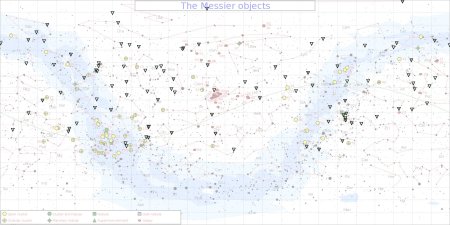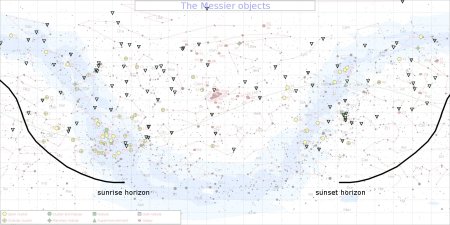
Apex 127 (left) and Travel Scope 70 (right) under dark skies on Mount Baldy. The Apex is on a SkyWatcher AZ4 mount, and the TS70 is on a Manfrotto CXPRO4 with a Universal Astronomics DwarfStar alt-az head. Photo by Terry Nakazono.
As promised in the last post, here are my thoughts on the scopes and charts I used up on Mount Baldy Saturday night. I haven’t had half of this stuff long enough for these to be considered true reviews, so I’m calling them “gear reports”.
Explore Scientific eyepieces–For a long time my workhorse eyepieces have been 32mm and 12mm Plossls and the 6mm Expanse. The 24mm ES68 gives the same true field as the 32mm Plossl but with higher magnification and a larger apparent field–68 degrees versus 52. The 14mm and 8.8mm ES82s give me a nice pair of mid-to-high power options, without taking business away from the 6mm Expanse.
How important is all that apparent field of view? I’ve also had the opportunity recently to look through a few TeleVue Ethos 100-degree eyepieces, and here are my impressions.
- Ethos: I could not quite see all of the field of view at once. I had to actually move my head around to see the field stop. It was nice–when I first looked in the eyepiece, at what was in the middle of the field, I could not immediately see the field stop in any direction. It actually was like looking through a window into space. I can see why people shell out big bucks for this experience (think $600 and up for the TeleVue Ethos models and $400 and up for the other brands).
- ES82: I can see all of the field and the field stop at once, but it is so far out to the edge of my field of view that I am not really aware of it. Very comfortable, too, in terms of eye placement and eye relief.
- ES68 and Orion Expanse (66-degree apparent field): ditto. For me, the jump from 52 degrees to 66 or 68 degrees is much more noticeable than the jump from the sixties up to 82–or back. I never went from one of the 82s to one of the sixties and thought, “oh, hey, where did my extra field go?”, which definitely does happen when I go directly from a widefield to a Plossl. My only explanation is that, at least for me, 66-68 degrees is over a threshold where additional apparent field makes little difference, until the I-can’t-see-it-all-at-once threshold I get with the Ethos.
- Plossls (52-degree apparent field): I like Plossls. They’re good, solid workhorse eyepieces, that can handle a wide range of focal ratios and tend to be sharp and have good light throughput. They were my go-to eyepieces for years. But, like many, many stargazers before me, I am spoiled now. The fact is, after using 66-82 degree eyepieces (I’ve had a pair of 68-degree Orion Stratuses for a couple of years, and just not used them much), going back to the Plossls is like being struck with tunnel vision: I am acutely aware that a lot of my visual real estate is occupied by non-sky inside-of-eyepiece black nothingness. That said, the effect really only jumps out at me when I swap a widefield for a Plossl back to back in the same scope. Saturday night I would be observing with widefields in the Apex and then wander over to the TS70 with the 32mm Plossl and not notice the sudden decrease in field. So I’m not getting rid of my Plossls anytime soon. For one thing, they all weigh much less than their widefield counterparts, and so play better in small scopes and travel kits.
By the way, if you’re in the market for budget Plossls and Expanse clones, check out the Black Knight Super Plossls and Enhanced Super-Wides at OWL Astronomy.
Apex 127–Under dark skies, a potent deep-sky instrument. Its maximum true field of just a bit over a degree will frame almost all deep sky objects, except for the very closest open clusters (like the Pleiades and Hyades). Everything I tried for, I found–my problems with the two open clusters were not that I could not see them, but that I could tell exactly what parts of the rich Milky Way starfields were supposed to be the clusters–more on this farther down. It’s also a planet-killer and excellent double-star scope. One night this spring I was trying to split a particularly tough double with this scope. It refused to budge at 257x, so I Barlowed my 6mm expanse to give 514x, and finally saw that stripe of black sky between the two stars. That’s about 100x per inch of aperture, or twice the rule-of-thumb “maximum effective magnification” of 50x per inch. Which means it’s a damn fine scope.
Travel Scope 70–Four things about this scope, three good, and one not so good. The good stuff first.
- It costs next to nothing. As I’ve pointed out in other posts, you can’t buy a 9×50 right-angle correct-image finder for what they’re charging for this scope.
- It’s small and light. I think it would ride on the same tripod as my SV50 and the scope itself takes up hardly any more room, but 70mm gathers roughly twice as much light as 50mm (5*5=25, 7*7=49). It has the same focal length as the venerable Short Tube 80 but weighs about half as much. You could think of it as a Short Tube 70, but its focal ratio of 5.7 is a hair more forgiving. That combined with the slightly smaller aperture should knock down the chromatic aberration a bit, compared to the ST80, and indeed I’ve found the CA unnoticeable in casual use, even on the moon and planets (that is, I’m sure it’s there if one goes hunting, but it’s never risen to the level of attracting my attention at the eyepiece).
- The optics are wonderfully clear. The low-power views are really bright and contrasty. I noticed this the first night I had the scope. I was cruising the summer Milky Way from my driveway, trying the 12.5x view with the 32mm Plossl for the first time. Now, Lyra was dead overhead, and atmospheric problems are almost always minimized at the zenith, but still, the view was bright, and I found the Ring Nebula, M57, right away. I thought “No way, there’s just no way the Ring is that easy at 12.5x. Must be an out-of-focus star.” So I started working my way up in magnification, and sure enough, it was the Ring after all. I noticed the same thing again Saturday night. I couldn’t see much detail on most of the Messier objects at that magnification, but they just jumped out of the background starfields, even the smaller ones. If you like low-power scanning, this scope is a blast under dark skies and still a fun ride even under so-so skies.
Now, the not-so-hot:
- It’s hard to push the magnification, and I don’t like the result when I do. A 12mm eyepiece gives 128x in the Apex 127, 108x in the 90mm Mak, and 100x in the XT10, but only 33x in this scope. A 6mm eyepiece gets you to 67x, but it ain’t worf it. The scope starts to pant around 40x and anything north of 60x is just bad. I noticed this the first night out, looking at Saturn and the moon, and it was still true this weekend. I don’t know if its astigmatism or poor collimation or what, but trying to achieve focus on planets is maddening. Jupiter goes from a vertical fan of red light on one side of focus to a horizontal fan of blue light on the other, and only sort of flirts with being a clean disk in between those extremes, at an infinitesimally tiny point that the rack-and-pinion focuser tends to shoot right past. It’s actually really puzzling to me that a scope that gives such clear, contrasty images at low power goes to crap so fast as the magnification goes up. (In case you’re wondering, we used exclusively low-power eyepieces with this scope for the Venus transit.)
So in the end the TS70 is kind of a one-trick pony. It is awesome for scanning around at low power and surfing the Milky Way. That’s the one thing it can do that neither of my Maks can. But unless you get a much better sample than I did, forget about doing any serious work at even moderate magnifications. The 90mm Mak is a much more versatile tool–it can do almost everything except widefield scanning. So at least the two small scopes complement each other.
UPDATE: the TS70 performs MUCH better after having been disassembled and reassembled (details in this post). It’s not hard, all it takes is a screwdriver. Blackening the lens edges with a Sharpie improves the scope’s already decent contrast, and shaking the lens cell a little while the objective lenses are loose will improve the collimation. After doing only that, I can now take this scope up to at least 133x without the image falling apart. It’s like a whole new scope. That said, there are still better choices out there – see my astronomy wish-list for beginning stargazers for some suggestions.
Actually the awesome low-power views of the TS70 have inspired me. A small ED refractor like the Astro-Tech AT72ED ought to give equally good low-power views and be able to take magnification well, and could potentially put both the TS70 and the 90mm Mak out of business. I don’t know if it actually will, but I aim to find out. So I think one of those will be my next big astro purchase–once I save up for it.
In the meantime, since the TS70 performs like a superfinder anyway, I’m going to keep scheming on how to turn it into one. I’d love to have it mounted side-by-side with the Apex 127, so I’d have a rich-field scope and a planet-killer on the same mount.
Pocket Sky Atlas–Since I started out in astronomy, the PSA has been essentially the only atlas I’ve used. It has stars down to magnitude 7.6 and about 1600 deep-sky objects. That includes all the Messiers, all the Caldwells, and all the Herschel 400s, plus another thousand or so, so it’s covered my needs and then some. The only time I’ve printed up my own finder charts has been for hunting quasars. I haven’t felt the need to move up to a “deeper” atlas until very recently.
I started thinking about a deeper atlas after observing with Terry Nakazono last month. His most-used atlas is the Observer’s Sky Atlas , which covers the whole sky to mag 6 but also has enlarged charts to mag 9 for finding 250 deep sky objects, including all the Messiers. He also prints out detailed finder charts from the Tri-Atlas (a huge free atlas in three versions: mag 9, 11, and 13). He was surprised that I’ve gotten along as well as I have with just the PSA.
, which covers the whole sky to mag 6 but also has enlarged charts to mag 9 for finding 250 deep sky objects, including all the Messiers. He also prints out detailed finder charts from the Tri-Atlas (a huge free atlas in three versions: mag 9, 11, and 13). He was surprised that I’ve gotten along as well as I have with just the PSA.
Part of the difference in preference probably has to do with the instruments that we use and how we get on target. Terry’s most-used scope is the SkyScanner 100 , which has a red-dot finder. So he gets in the neighborhood–or closer, sometimes you can really bullseye things with an RDF–with the dot finder and then star-hops to his targets at the eyepiece. In contrast, I use a 9×50 RACI
, which has a red-dot finder. So he gets in the neighborhood–or closer, sometimes you can really bullseye things with an RDF–with the dot finder and then star-hops to his targets at the eyepiece. In contrast, I use a 9×50 RACI finder on whatever scope I am observing with (I only have one, and just move it around among scopes), and do almost all of my star-hopping with the finder alone. The 50mm finder does not go nearly as deep as the 100mm reflector–it simply shows fewer stars–so I often use the geometrical method of centering the finder on an unseen target (this is detailed by Harvard Pennington in The Year-Round Messier Marathon Field Guide
finder on whatever scope I am observing with (I only have one, and just move it around among scopes), and do almost all of my star-hopping with the finder alone. The 50mm finder does not go nearly as deep as the 100mm reflector–it simply shows fewer stars–so I often use the geometrical method of centering the finder on an unseen target (this is detailed by Harvard Pennington in The Year-Round Messier Marathon Field Guide and by Stephen Saber in his post on “sharpshooting” deep-sky objects–search for it here). I hadn’t given this much thought before Terry brought it up, but my less-deep atlas suits my finder-driven navigation, whereas eyepiece starhopping really requires that you be able to see as many charted stars as possible to keep from getting lost. So we have each gravitated toward the atlas that best suits our observing style–or rather, I started with PSA and never had a reason to gravitate away.
and by Stephen Saber in his post on “sharpshooting” deep-sky objects–search for it here). I hadn’t given this much thought before Terry brought it up, but my less-deep atlas suits my finder-driven navigation, whereas eyepiece starhopping really requires that you be able to see as many charted stars as possible to keep from getting lost. So we have each gravitated toward the atlas that best suits our observing style–or rather, I started with PSA and never had a reason to gravitate away.
Until now, that is. The problem is not that the PSA doesn’t show enough deep-sky objects. I’ve only seen about a fifth of its 1600 plotted DSOs. The problem, as Terry pointed out, is that it just doesn’t show enough stars, at least for some problems. In trying to track down some of those small open clusters in Cygnus and Cassiopeia, I found that the plotted symbol in the PSA covered a good-sized field that was striped and mottled with star chains and asterisms of the summer Milky Way. The geometrical relationships shown in the PSA just weren’t enough. I couldn’t go to “the” cluster of stars that made an equilateral triangle (or whatever) with the nearest guide stars, because there half a dozen plausible candidates (actually, this might be a not-enough-DSOs plotted problem as well as a not-enough-stars problem). I need to see some of the fainter stars in between plotted on the chart, to break up those rich starfields into manageable–and interpretable–chunks.
So, to make a long story short, I ordered the first volume of Uranometria 2000.0 , a mag 9 atlas, and I’ll get the other two volumes as funds allow. Stay tuned.
, a mag 9 atlas, and I’ll get the other two volumes as funds allow. Stay tuned.

(I also have a second copy, autographed by John Dobson, that actually is an heirloom piece now). The circles and polygons flag objects from various Astronomical League observing projects. Triangles are double and multiple stars, rectangles are Herschel 400 objects, big circles are for the Binocular Deep Sky objects, and an open letter C designates Caldwell objects. I also drew in the position of Almach, which is just off the edge of this chart, wrote in the number for the multiple star 57 Persei, and wrote down the magnitudes of Algol and some of the useful reference stars, including Almach. Arrows in the margins are left over from my Caldwell tour.
has all of the AL Binocular Double Star targets marked, and I use my Jumbo PSA
(which is ridiculously useful) to keep track of targets from the last several years of Sky & Telescope’s Binocular Highlight column, to help me avoid repeats. Of course I have other lists for all of these things, both physical and digital, but it’s nice to have an easy reminder when I am out observing or doing desk research.






